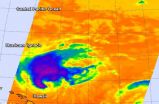NASA sees wind shear affecting Hurricane Ignacio
2015-09-01
(Press-News.org) Hurricane Ignacio is staying far enough away from the Hawaiian Islands to not bring heavy rainfall or gusty winds, but is still causing rough surf. Infrared satellite data on September 1 shows that wind shear is adversely affecting the storm and weakening it.
The Atmospheric Infrared Sounder or AIRS instrument that flies aboard NASA's Aqua satellite gathers infrared data that reveals temperatures. When NASA's Aqua satellite passed over Ignacio on September 1 at 11:41 UTC (7:41 a.m. EDT), the AIRS data and showed some high, cold, strong thunderstorms surrounded the center where cloud top temperatures were near -63F/-53C. However, AIRS also showed that southwesterly wind shear was pushing the thunderstorms to the northeast of the low-level center.
The National Hurricane Center noted that infrared data showed the central dense overcast clouds had now been completely sheared away and replaced with a "warmer banding feature across the western and northern semicircles." That means weaker thunderstorms with less cold cloud top temperatures, because there wasn't as much uplift in the atmosphere to push them higher.
On September 1 at 8:00 a.m. EDT an infrared image from NOAA's GOES-West satellite clearly showed that that southwesterly vertical wind shear was affecting the storm. In the image it appeared that Ignacio developed a tail that extended to the northeast as its clouds and thunderstorms were being pushed in that direction.
At 11 a.m. EDT (1500 UTC/5 a.m. HST), the center of Hurricane Ignacio was near latitude 23.5 north and longitude 153.7 west. That's about 310 miles (495 km) east-northeast of Honolulu, Hawaii, and 275 miles (445 km) north-northeast of Hilo. The estimated minimum central pressure is 984 millibars.
Ignacio's maximum sustained winds dropped to near 80 mph (130 kph). That means that Kilo is a category one hurricane on the Saffir-Simpson Hurricane wind scale. The Central Pacific Hurricane Center expects Ignacio to slowly weaken through early Thursday, September 3.
NOAA's Central Pacific Hurricane Center noted that large swells generated by Ignacio will continue along east and northeast facing shores of the Hawaiian Islands over the next couple of days. Resultant surf will be large...potentially damaging and life-threatening.
INFORMATION:
[Attachments] See images for this press release:


ELSE PRESS RELEASES FROM THIS DATE:
2015-09-01
EUGENE, Ore. - Sept. 1, 2015 - The University of Oregon's Kelly Sutherland has seen the future of under-sea exploration by studying the swimming prowess of tiny jellyfish gathered from Puget Sound off Washington's San Juan Island.
In a paper with four colleagues in the Sept. 2 issue of the journal Nature Communications, Sutherland details how a tiny type of jellyfish - colonial siphonophores - swim rapidly by coordinating multiple water-shooting jets from separate but genetically identical units that make up the animal.
Information on the biomechanics of a living organism ...
2015-09-01
WOODS HOLE, MASS.--Marine animals that swim by jet propulsion, such as squid and jellyfish, are not uncommon. But it's rare to find a colony of animals that coordinates multiple jets for whole-group locomotion. This week in Nature Communications, scientists report on a colonial jellyfish-like species, Nanomia bijuga, that uses a sophisticated, multi-jet propulsion system based on an elegant division of labor among young and old members of the colony. This locomotive solution, the team suggests, could illuminate the design of underwater distributed-propulsion vehicles.
"This ...
2015-09-01
Here's another discovery to bolster the case for medical marijuana: New research in mice suggests that THC, the active ingredient in marijuana, may delay the rejection of incompatible organs. Although more research is necessary to determine if there are benefits to humans, this suggests that THC, or a derivative, might prove to be a useful antirejection therapy, particularly in situations where transplanted organs may not be a perfect match. These findings were published in the September 2015 issue of The Journal of Leukocyte Biology.
"We are excited to demonstrate for ...
2015-09-01
COLUMBIA, Mo. - Forgiveness is a complex process, one often fraught with difficulty and angst. Now, researchers in the University of Missouri College of Human Environmental Sciences studied how different facets of forgiveness affected aging adults' feelings of depression. The researchers found older women who forgave others were less likely to report depressive symptoms regardless of whether they felt unforgiven by others. Older men, however, reported the highest levels of depression when they both forgave others and felt unforgiven by others. The researchers say their ...
2015-09-01
Police officers face an elevated risk of being injured in a collision when they are sitting in a stationary car as compared to low-speed driving, as well as when they are responding to an emergency call with their siren blaring as compared to routine patrol, according to a new RAND Corporation study.
In addition, officers face a higher risk of being injured in a crash when they are riding a motorcycle compared to a driving a car, driving solo compared to having a second officer in the car, or not wearing a seatbelt compared to wearing a seatbelt.
The findings provide ...
2015-09-01
With a name like "Alcoholic Liver Disease," you may not think about vitamin A as being part of the problem. That's exactly what scientists have shown, however, in a new research report appearing in the September 2015 issue of The FASEB Journal. In particular, they found that chronic alcohol consumption has a dramatic effect on the way the body handles vitamin A. Long-term drinking lowers vitamin A levels in the liver, which is the main site of alcohol breakdown and vitamin A storage, while raising vitamin A levels in many other tissues. This opens the doors for novel treatments ...
2015-09-01
The study, published today at Nature Methods (the most prestigious journal for the presentation of results in methods development), proposes the use of two plant protein epitopes, named inntags, as the most innocuous and stable tagging tools in the study of physical and functional interactions of proteins.
Proteins and peptides of various sizes and shapes have been used since the early 80s to tag proteins with many different purposes, ranging from affinity purification to fluorescence-based microscopic detection in whole organisms. However, tagging strategies used nowadays ...
2015-09-01
Imagine being in a car with the gas pedal stuck to the floor, heading toward a cliff's edge. Metaphorically speaking, that's what climate change will do to the key group of ocean bacteria known as Trichodesmium, scientists have discovered.
Trichodesmium (called "Tricho" for short by researchers) is one of the few organisms in the ocean that can "fix" atmospheric nitrogen gas, making it available to other organisms. It is crucial because all life -- from algae to whales -- needs nitrogen to grow.
A new study from USC and the Massachusetts-based Woods Hole Oceanographic ...
2015-09-01
If you have diabetes and cancer, here's some hope. In a new research report appearing in the September 2015 issue of The FASEB Journal, scientists reveal a newly discovered tissue- and organ-specific mechanism that regulates blood vessel growth, and when inhibited reduced the growth of tumors in diabetic mice. In addition to the treatment of the diabetes-related cancers, the approach may be also used to treat other diabetic complications that are associated with the increased blood vessel growth, like retinopathy or nephropathy for example.
"Complications of diabetes ...
2015-09-01
Costs for spinal fusion vary substantially by region, with costs being lowest in the Midwest and highest in the Northeast, according to the new research by Dr. W. Ryan Spiker and colleagues of University of Utah, Salt Lake City. They write, "This data sheds light on the actual cost of common surgeries throughout the United States, and will allow further progress towards the development of cost effective, value driven care."
New Data on 'Actual Costs' of Common Spine Surgeries
The researchers analyzed 2012 Medicare data on the costs of two common types of spinal fusion ...
LAST 30 PRESS RELEASES:
[Press-News.org] NASA sees wind shear affecting Hurricane Ignacio



